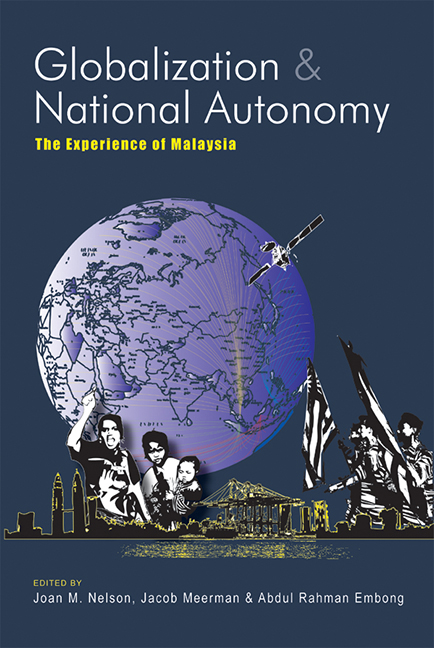Book contents
- Frontmatter
- Contents
- List of Abbreviations
- List of Tables and Figures
- Preface
- Contributors
- Chapter 1 Introduction
- Chapter 2 Developmentalist State in Malaysia: Its Origins, Nature, and Contemporary Transformation
- Chapter 3 The Look East Policy, the Asian Crisis, and State Autonomy
- Chapter 4 The Malaysian Success Story, the Public Sector, and Inter-ethnic Inequality
- Chapter 5 Poverty Eradication, Development, and Policy Space in Malaysia
- Chapter 6 Trade Liberalization and National Autonomy: Malaysia's Experience at the Multilateral and Bilateral Levels
- Chapter 7 Malaysia's Education Policies: Balancing Multiple Goals and Global Pressures
- Chapter 8 Malaysia's Healthcare Sector: Shifting Roles for Public and Private Provision
- Chapter 9 Globalization, Islamic Resurgence, and State Autonomy: The Response of the Malaysian State to ‘Islamic Globalization’
- Chapter 10 The National Culture Policy and Contestation over Malaysian Identity
- Chapter 11 Conclusions
- Index
Chapter 2 - Developmentalist State in Malaysia: Its Origins, Nature, and Contemporary Transformation
Published online by Cambridge University Press: 21 October 2015
- Frontmatter
- Contents
- List of Abbreviations
- List of Tables and Figures
- Preface
- Contributors
- Chapter 1 Introduction
- Chapter 2 Developmentalist State in Malaysia: Its Origins, Nature, and Contemporary Transformation
- Chapter 3 The Look East Policy, the Asian Crisis, and State Autonomy
- Chapter 4 The Malaysian Success Story, the Public Sector, and Inter-ethnic Inequality
- Chapter 5 Poverty Eradication, Development, and Policy Space in Malaysia
- Chapter 6 Trade Liberalization and National Autonomy: Malaysia's Experience at the Multilateral and Bilateral Levels
- Chapter 7 Malaysia's Education Policies: Balancing Multiple Goals and Global Pressures
- Chapter 8 Malaysia's Healthcare Sector: Shifting Roles for Public and Private Provision
- Chapter 9 Globalization, Islamic Resurgence, and State Autonomy: The Response of the Malaysian State to ‘Islamic Globalization’
- Chapter 10 The National Culture Policy and Contestation over Malaysian Identity
- Chapter 11 Conclusions
- Index
Summary
INTRODUCTION
Much of the literature on the fast growth economies of East and Southeast Asia in the last two decades has focused on the role of the state in development, and advanced the notion of what is known as the “developmentalist state” model. With Chalmers Johnson (1982) taking the lead in the early 1980s to expound the role of the developmentalist state in creating the Japanese “miracle”, a number of others have also taken up the same theme several years later. These included such scholars as Deyo (1987), Amsden (1989), Wade (1990), Appelbaum and Henderson (1992), Castells (1992), Fitzgerald (1994) and Weiss and Hobson (1995) who examined the rapid economic growth of the region by focusing, among other topics, on the role of the state in promoting industrialization and social transformation. On Malaysia, quite a number of works have also been written, mainly by economists, sociologists and political scientists, on the state's involvement in the economy and industrialization (see especially Toh 1982, Jomo 1986, Jesudason 1990, Lubeck 1992, Faaland, Parkinson and Rais Saniman 2003, Gomez 1997, Ishak 2002) as well as the role of the state in creating the new middle class (Abdul Rahman 1996, 2002, 2004, Kahn 1996a, 1996b). The state's role in the economy is considered especially crucial in ensuring the implementation of the objectives of the New Economic Policy, viz. the eradication of poverty and the restructuring of society. Although the literature is quite extensive especially on the New Economic Policy and the state's involvement and its consequences, the question of the Malaysian state as a developmentalist state, its origins and nature, state capacity and its transformation over time has not been directly addressed except in an unpublished doctoral study submitted to Universiti Kebangsaan Malaysia by Sity Daud (2003). Sity deals with certain aspects of the question by examining it through the implementation of the NEP (1971–90) and the National Development Plan (1991–2000).
This chapter is a modest attempt to deal with the question of the Malaysian state as a developmentalist state, its origins and nature, as well as the transformation of its capacity and autonomy in engaging with globalization from the 1970s to the present. It first seeks to explain the origins and nature of the Malaysian developmentalist state, and then examine some components of state capacity that enable the state to undertake development and advance the public good.
- Type
- Chapter
- Information
- Globalization and National AutonomyThe Experience of Malaysia, pp. 27 - 58Publisher: ISEAS–Yusof Ishak InstitutePrint publication year: 2008

